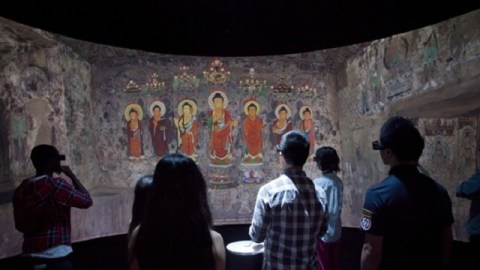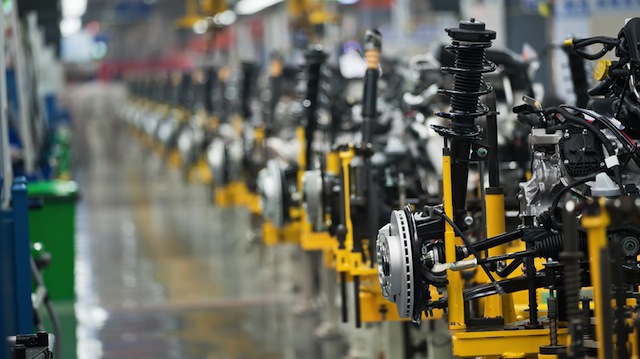Will This Be the Museum of the Future?

Imagine walking into a 1,300-year-old Buddhist cave carved from a cliff overlooking a stretch of the ancient Silk Road in Dunhuang, China. You point your flashlight and frescoes showing musicians and bodhisattvas come alive with sound and color. The experience is life-changing. Now imagine doing all that in a room in a museum thousands of miles from the Silk Road. When the Arthur M. Sackler Gallery at the Smithsonian Institution in Washington, DC, hosted Pure Land: Inside the Mogao Grottoes at Dunhuang last week (shown above), it marked not just a groundbreaking new standard for virtual reality exhibitions, but also a glimpse of what the museum of the future may look like. Where paintings and sculpture fill galleries today, could immersive virtual realities and 3D printed replicas of priceless originals fill the physical (and online) galleries of tomorrow?
For one tantalizing brief week at the beginning of December, the Sackler set up a tent in their garden courtyard containing the Pure Land “virtual cave” created by Jeffrey Shaw, dean of the School of Creative Media, City University of Hong Kong (CityU), and developed by ALiVE, an interdisciplinary art research initiative at CityU, in partnership with the Dunhuang Academy and the Friends of Dunhuang Hong Kong. (A video of Shaw talking about the project and footage of the cave in action can be seen here.) Inside the tent, five projectors and a series of sound speakers connected to a network of computers responded to the commands of 3D-glasses-wearing patrons wielding iPad Mini controllers. Viewers can highlight parts of the murals to make bodhisattvas fly or musicians play once more (or how modern interpreters think they would sound). If you want to play Indiana Jones, you can use a virtual flashlight to illuminate one detail at a time. Another push of a button and the faded frescoes travel back in time to their original, stunning freshness.
You can’t enter the actual cave anymore because it has been declared an endangered site, so Pure Land isn’t just the next best thing to being there—it’s in many ways better than being there. After watching Cave of Forgotten Dreams, Werner Herzog’s film about Chauvet Cave, the southern France site of some of the earliest cave paintings ever found, I wished I could go there and see it with my own eyes, but, after the damage from visitors to Lascaux Cave, non-researchers will most likely never be allowed to visit that site or any other fragile, ancient place. But with these advances in virtual reality technology, we may all one day be able to “visit” these sites virtually and come to understand the past in a wholly new way.
“Hold on, Mr. Holodeck,” you might be saying. “Museums aren’t about virtual reality.” I beg to differ. What is the Metropolitan Museum of Art‘s Temple of Dendur—an Egyptian temple transplanted to the heart of New York City—if it isn’t (albeit analog, rather than digital) virtual reality? The Philadelphia Museum of Art, my hometown museum, just to give another example, allows you to enter a Hindu temple, a 13th century French cloister, a Japanese teahouse, and a Chinese scholar’s study all under one encyclopedic roof. Museums are already in the virtual reality business, but they’re just doing it the old school way of carting the real thing through space and time to your door. Pure Land brings pure virtual reality to your door with minimum fuss and muss and with the added benefits of leaving the originals in place (see “Marbles, Elgin”) and allowing multiple institutions to “host” the same site. With a dedicated virtual reality theater, a museum could rotate an endless array of virtual experiences—literally bringing the entire world under one roof.
But what if you still like looking at physically real objects and not just elaborately projected images? As Joseph Flaherty at Wired recently reported, a team from Harvard University used a process called “photomodeling” to photograph fragments of sculpture from hundreds of angles to create 3D renderings of each piece, which they then fit together into a “semi-complete 3-D model of the original artifact.” Comparing that semi-complete version to more complete statues, the team filled in the missing gaps. Finally, those missing pieces were created using a 3D printer. Harvard’s not alone in this new use of 3D printing technology to put the past back together. “Archaeologists at Cornell have 3-D printed Cuneiform tablets, researchers at Loughborough University in the U.K. are restoring artifacts from China’s Forbidden City using 3-D printers, and students at Texas A&M are recreating Roman tools with the same methods,” Flaherty writes. But if 3D print technology can reassemble Roman tools, it can also generate additional complete physical objects to be seen and maybe even held in a museum setting. The cost of 3D printing’s prohibitive today, but the day isn’t far off that a museum could create objects museumgoers can handle. Imagine a day when touching an artifact from the Forbidden City’s no longer forbidden.
Virtual environments and 3D printed displays assume that bricks and mortar museums will last. I believe that we’ll always need a gathering place to consume culture and share the human experience of art with other humans, but I also see the allure and place for online museums and exhibits. Google Art Project and similar online gallery projects on multiple platforms (even Second Life) are coming closer and closer to realizing the idea of an online museum. The Estorick Collection of Modern Italian Art recently launched their first online exhibition on Futurism and the Past, which links the 20th century Futurist movement with the Renaissance and other periods by making connections impossible in a real world, “meatspace” museum exhibition. Perhaps all museums in the future will themselves be virtual, online spaces, or maybe they’ll be some hybrid of real and cyberspace. As bricks and mortar museum buildings and skyrocketing art prices price out certain institutions, perhaps a virtual gallery space and 3D printer might eventually become the economically logical alternatives in an austerity-driven society. However, recent developments in technology affirm that the museum in some form will survive as the cutting-edge past pushes paradoxically further and further into the human past to show us the inspirational, the fantastical, and the beautiful such physically and temporally distant places can offer.





